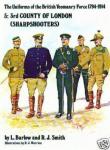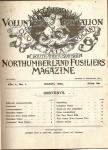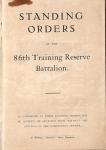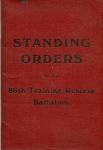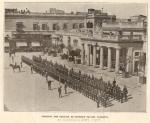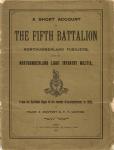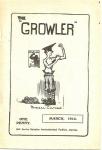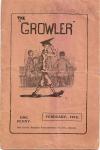-
Posts
1,065 -
Joined
-
Last visited
-
Days Won
1
Content Type
Profiles
Forums
Blogs
Gallery
Events
Store
Everything posted by Graham Stewart
-
Hi CB & welcome to the GMIC. Cavalry uniforms aren't really my field, but I think I know the pattern uniform that you're on about. In all of the illustrations I have seen, where shoulder chains are worn and with coloured collars, they appear to be worn by Yeomanry regiments. For instance the Northumberland Hussars had a light blue facing collar, but it was worn with a dark blue jacket and not scarlet. As for illustrations an old friend of mine - "Bob Marrion" did a lot of work for the "Military Modeller" magazine in the 1980/90's and I recall a particular edition which covered Yeomanry regiments and in particular coloured facings. He also did a lot of illustrations for a series of books that can be bought on E.bay, but I can't remember the title for the moment. The Fosten brothers also did a series in the same magazine called "The Cut of the Cloth", which was beautifully illustrated in their particular style and they did cover all of the regular cavalry. Apologies if it's not the best answer I can give, but I'll try and direct you to the relevant reference books available here in the UK(thats if you haven't already got them).
-
As pointed out he is a WOI in the photo i.e. "Regimental Sgt Major" as opposed to a WOII, but for a short period during the early 1920's I believe both WOI & WOII dressed in better quality service dress and also wore the Sam Browne, being only identified by their rank badges. This privilege was eventually withdraw for the WOII.
-

What unit?
Graham Stewart replied to Noor's topic in Great Britain: Orders, Gallantry, Campaign Medals
Is this the same unit which was put together by the British to assist the White Russians fighting the Communists in North Russia? If so I'm not surprised there are so few MIC's for them, because if I remember correctly some of the units mutinied and murdered their British officers. -
Your observations have prompted to do a bit of hunting and I remembered I have a framed "Battalion Order No.6" in the loft from the C.O. of the 6th Bn, NF congratulating the Battalion on their turnout and stature during the recent Royal visit in October 1928. Going off that, I had a trawl through my St.George Gazettes for October 1928 and sure enough on the 10th October 1928 the City of Newcastle did have a Royal visit for a rather special occassion. The occassion was the opening of Tyne Bridge and both the 5/68th Depot and the 6th Bn, NF provided guard etc for the visit and civic dignataries of both Newcastle and Gateshead. Considering the anomalies in the type of instrument, the trumpet banners and uniform I have reason to believe that this was possibly taken during this occassion. Both the Depot element and the 6th Bn as a whole paraded in SD with Colours flying. Sadly there is no photo of the 6th Bn band, but I suspect scarlet would be the dress of the day for them.
-
Hi David - I think we just used the term "trumpeters" as a general description as we still haven't discovered exactly what their role is. I noted the buglers cords, but they aren't wearing drummers uniforms either, which one would have expected, as all of the battalion bands regular and TF/TA comply with dress regs for bands. Looking at the trumpets(which appear to have keys too) and trumpet banners which are adorned by the City arms of Newcastle-on-Tyne, they appear to be acting in a civic role on behalf of the City, so they may well be unofficially titled "Lord Mayors trumpeters" or "Civic trumpeters". They may have also shared the role with other units which were based around the city i.e. Northumberland Hussars. As it stands though it's the first time I've seen them using this type of instrument, but still don't why or what the occassion was.
-
Here we have the cover of what I would rate as possibly the rarest of the regimental journals and this is the "3rd V.B., N.F. Magazine" which was first published in March 1905, with Volume I running through to May 1906. At which things seem to get a bit sketchy as to it's publication dates. The publication run goes March(Vol; 1 No.1); April(Vol 1 No.2); May(Vol 1 No.3); June(Vol 1 No.4); July(Vol 1 No.5); August(Vol 1 No.6); September(Vol 1 No.7); October(Vol 1 No.8); November(Vol 1 No.9); December(Vol 1 No.10}; February(Vol 1 No.11); May(Vol 1 No.12). The month of January 1906 was for some strange reason omitted, as February should have been No.12. Volume II would have naturally ran from March 1906 through to February 1907, but both it and April 1906 are omitted. As I don't have Volume II, I can't say when it began, but Volume III No.1 begins in November 1907 through to April 1909, while having become the "6th Battalion Northumberland Fusiliers Magazine" in May 1908. Confused - well so am I as Volume IV No.1 begins May 1909 and then ends in June 1910 at No.8 in the bound volume I have???? Ah well it's still a great little journal
-
Another pamphlet which on initial viewing appears to have nothing to do with the Northumberland Fusiliers, is this one "Standing Orders of the 86th Training Reserve Battalion". The link with the Northumberland Fusiliers is that on the formation of the Training Reserve, the 31st(Reserve)Bn, Northumberland Fusiliers (formerly the Depot Companies of the 16th(Service)Bn), was transferred to this new "Corps" on 1st September and redesignated the 86th Training Reserve Bn. The role of the battalion was to act as a training & draft finding unit and it also re-trained many former members of the 16th Bn who had recovered from wounds/sickness and who required a course of recuperation and physical training to bring them back up to physical standard. By the time this booklet was published in March 1918 the training was more geared towards the handling of newer recruits called up under Military Services Act of 1916 i.e. conscripts, although former frontline soldiers, many of them Northumberlands, would still continue to pass through the battalion on recuperation.
-
During the South African War the 3rd(Militia)Bn, Northumberland Fusiliers was embodied for service and also re-designated as the 5th(Militia)Bn, Northumberland Fusiliers. This was due to the fact that the regiment was expanded by a further two regular battalions, which were subsequently titled the 3rd & 4th Bn's, Northumberland Fusiliers. Shortly after embodiement the battalion was shipped to Malta as a relieving "Garrison Battalion", until disembodied in 1901. All members of the battalion who were embodied and serving in Malta went onto receive the Mediteranean Medal. This small & rare account of it's service was edited by Major & Adjutant G.F.T.Leather and printed by G.W.Grigg & Son Printers, Dover in 1902.
-
Going back to Mikes earlier post and the items recently obtained by him regarding the 27th Northumberland Light Infantry Militia. Here we have a copy of their first history in paperback and published in 1877 and printed by Robert Robinson of Pilgrim Street, Newcastle-upon-Tyne. Written by Senior Captain & Honorary Major William Adamson it covers the battalions history from 1853 - 1876. In 1914 it was reprinted in hardback by Andrew Reid & Co. Ltd, Printers & Publishers, Akenside Hill, Newcastle with additional material regarding the battalions history by Major & Hon. Lt.-Col. Robert Scott and retitled "The Services of the 27th Northumberland Light Infantry Militia now the 3rd Battalion, Northumberland Fusiliers".
-
Now for a series of covers of what is believed to be the only Battalion magazine produced by a NF Battalion during the Great War. The magazine itself was entitled "The Growler" and was produced monthly for the 16th(Service)Bn, Northumberland Fusiliers(Newcastle)and printed by W.L.Large & Sons Ltd, 52-54 Shields Rd, West, Newcastle-on-Tyne. The magazine in essence is a battalion 'skit' taking a light hearted look at those who served in it. These originally belong to 16/1027 Cpl(later Sgt & WOII David Walter Smith, of 'D' Coy, 16th Bn, who luckily survived the war and who was later posted to the 19th(Service)Bn. He was also awarded an M.M. on 1st January 1918. Hopefully our readers won't mind viewing the individual covers of these few surviving examples.
-
Now for some lesser well known pamphlets of the Northumberland Fusiliers. Here we have a short history pamphlet by Alfred Brewis relating to the formation of three "Commercial" battalions raised during the beginning of WWI. Alfred Brewis was in some ways the pre-WWI curator/historian of the NF and his son Lieut Alfred Percy Brewis(1st Bn, NF)was to die of wounds 1st June 1917 whilst attached to the 1/5th East Lancs Regt. This little pamphlet was produced during the heady days of recruiting for Kitcheners New Armies and dealt with the raising of the 16th, 18th & 19th(Service)Battalions and was printed the 1st March 1915. The 17th(Service)Bn were to be raised by the North Eastern Railways, but there had been plans to have a full "Commercial" Brigade of four battalions, but alas the fourth battalion was never raised.


